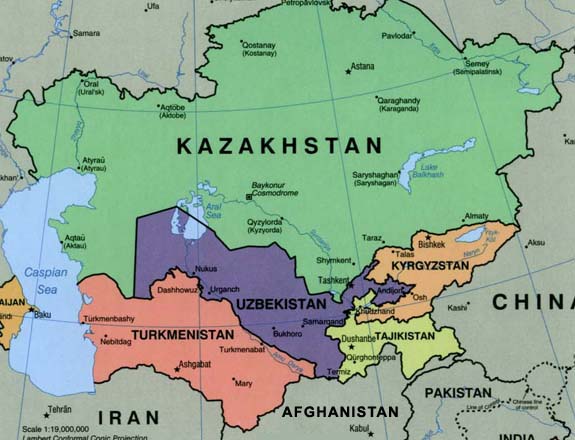Examining Linguistic Trends in Central Asia

In 2001, Jacob M. Landau and Barbara Kellner-Heinkele published the book The Politics of Language in the Ex-Soviet Muslim States, a unique and timely analysis of language policies in the central Asian states of the former Soviet Union. Mark Berniker, a freelance journalist who specializes in the politics and economics of Central Asia, the Caucasus and Russia, offers a precise book review.
Language policy in Soviet Union
For Kremlin leaders during the Communist era, language was a key tool in their efforts to forge a new Soviet identity. Russia was supposed to unify the inhabitants of the ethnically and culturally diverse empire. These days, language is again a central element of government policy in post-Soviet states, only it�s being used to separate rather than unify.
The collapse of the Soviet Union occurred suddenly in 1991, thrusting independence on countries that were not necessarily prepared for it. Many leaders, including those in Central Asia, initially promoted indigenous cultural and linguistic traditions, including the Islamic faith, as a way to bolster state sovereignty. With the passage of time, however, these leaders have tempered their enthusiasm for the cultural revival, coming to see it as a potential threat to the existing political framework.
The shifts in ethnic identity and linguistic patterns in Central Asia are the subject of careful examination by authors Jacob M. Landau and Barbara Kellner-Heinkele in their book, The Politics of Language in the Ex-Soviet Muslim States. While noting that a decade is a relatively short period, historically speaking, the authors illustrate the varying degrees of linguistic change in the region.
The outcomes of Soviet Russification policy
The book focuses on policies in the five Central Asian states � Kazakhstan, Kyrgyzstan, Tajikistan, Turkmenistan, and Uzbekistan. But it also includes Azerbaijan, a Caucasus country with an Islamic cultural heritage. One of the book�s central premises is that Soviet Russification policies made fewer inroads into shaping the identities of citizens in the six Muslim republics than previously believed.
«The Soviet policy of linguistic Russification had been only partly successful in the six Muslim republics,» the authors observe. «While knowledge of Russian, particularly after the end of the Second World War, spread rapidly, chiefly in urban areas, it did not preclude continuing loyalty to the native tongues in a great number of cases, with Russian becoming the second language.»
The authors contend that Azerbaijan, Uzbekistan and Turkmenistan have «progressed more visibly in promoting the titular language in administration and schooling, including the preparation and introduction of new textbooks in the Latin alphabet.» Landau and Kellner-Heinkele go on to state that Kazakhstan and Kyrgyzstan «inhabited by proportionately large Slav minorities, have invested more organizational efforts in language planning, but have achieved less.»
When it comes to language policy, the reality is that adults and the elderly are not likely to profoundly transform their language patterns. But change is far more likely with youth at all educational levels. «All the governments involved have shown more interest in promoting the titular language at school than among adults, for whom less has been done, either to instruct them in the language or in a new script,» the authors remark.
In some areas of Central Asia, especially where Soviet policies never succeeded in sinking deep roots, the use of Russian has virtually disappeared over the past decade. An individual who is exclusively a Russian speaker in the Uzbek portion of the Ferghana Valley, for example, could encounter difficulty in communicating today.
A primary consequence of the changing language patterns has been emigration by Russian-speakers, many of whom are skilled laborers and professionals. The emigration trend has been heaviest in Kazakhstan, where, according to some estimates, up to 2 million Russian speakers have left the country. A similar trend has been reported in Kyrgyzstan, although the overall numbers are far lower.
Linguistic and cultural policies may be an important factor in the emigration equation. But other variables, including those related to economics, exert considerable influence on the decision making processes of Russian speakers. In recent years, concerns about Islamic radicalism and terrorism have also become a point of consideration.
The emigration pace now appears to be easing. In Kyrgyzstan, for example, authorities reported that applications to emigrate to Russia fell by 60 percent in 2002, compared with the previous year. But some experts believe the decline does not necessarily reflect a state of contentment among Russian speakers. It may be that many simply lack the means and/or ability to leave Central Asia.
Supporting the titular language
One trend that emerges from the book is that supporting the titular language has proven politically expedient for regional leaders. In Kazakhstan, for example, the titular nationality did not constitute a majority of the population during the late Soviet era. Since independence, amid the large-scale emigration of Russian speakers, the Kazakh share of the population has climbed above 50 percent, according to official statistics.
«Unwilling to support monolingualism at the present time, political leaders in the six independent states have striven to adopt a new vision of bilingualism, where de-Russification is expressed in promoting the titular language to the first place and downgrading Russian to the second,» remark Landau and Kellner-Heinkele.
The book also underscores another important aspect of the past decade�s developments; the Soviet collapse didn�t mean that everyone in the Caucasus and Central Asia suddenly abandoned their ability to speak, read, and write in Russian. Urban elites and government officials did not completely shun their connections to the language or the vestiges of institutions that remained in the aftermath of the Soviet state. Indeed, many realize that knowledge of Russian remains important for commercial and educational purposes, offering the best and most lucrative opportunities for aspiring entrepreneurs and students.
Taken from: Mark Berniker, Examining Linguistic Trends in Central Asia
See also: Jacob M. Landau and Barbara Kellner-Heinkele (2001) The Politics of Language in the Ex-Soviet Muslim States C. Hurst & Co.



